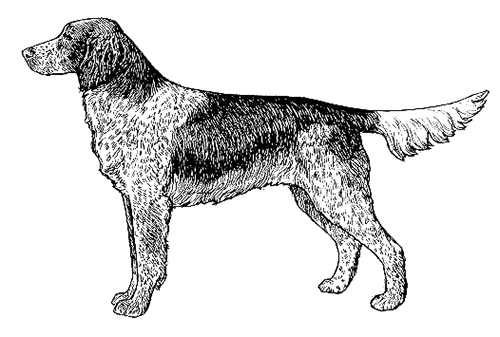Large Munsterlander
Gun Dog Group
The goals and purposes of this breed standard include: to furnish guidelines for breeders who wish to maintain the quality of their breed and to improve it; to advance this breed to a state of similarity throughout the world; and to act as a guide for judges.
Breeders and judges have the responsibility to avoid any conditions or exaggerations that are detrimental to the health, welfare, essence and soundness of this breed, and must take the responsibility to see that these are not perpetuated.
Any departure from the following should be considered a fault, and the seriousness with which the fault should be regarded should be in exact proportion to its degree and its effect upon the health and welfare of the dog and on the dog’s ability to perform its traditional work.
History
The Large Munsterlander is descended from the parti-colored bird and hawking dogs used in the Middle Ages. It was developed in Germany, and was divided into a distinct breed, separate from the other German Longhaired pointing breeds, in 1919. The breed was recognized by the United Kennel Club in 2006.
General Appearance
A versatile pointing gun dog that is especially well known for its ability to locate and retrieve shot game, the Large Munsterlander is a black and white dog with elegant, clean lines and a distinct look of nobility. He gives the immediate impression of possessing a combination of strength and refinement.
Characteristics
First and foremost a working gun dog, this breed must be tractable, trainable and intelligent. It has a lively temperament, but is never nervous or hyperactive.
Head
SKULL
Long and moderately wide, with a medium amount of stop.
MUZZLE
Long and strong, with a well developed underjaw. Nasal bone is straight. Lips are not pendulous.
Faults: Roman nose, dished face.
TEETH
A full complement of strong teeth meet in a scissors bite.
Minor Faults: Level bite, missing first or second premolars or third molar.
EYES
Of medium size, with tight fitting lids. Dark brown in color, with no haw showing.
Faults: Light eyes, loose lids with prominent haw.
NOSE
Black in color, fully pigmented.
Fault: Butterfly nose.
EARS
Broad at the base, tapering to the tips, set on high and carried close to head.
Faults: Low set ears or ears that are not carried close to the head.
Neck
Medium in length, strong, and gracefully arched.
Fault: Presence of dewlap.
Forequarters
Shoulder blades fit smoothly into the body, and have good angulation with the upper arm.
FORELEGS
Long, straight and strong. Pasterns slightly sloping and springy. Distance from elbow to ground is slightly greater than the distance from withers to elbow.
Fault: Crooked legs
Body
Square in proportion, measured from breastbone to buttocks and withers to ground. Chest broad and deep, with well developed forechest. Withers fairly high, back short and straight. Ribs moderately sprung. Loin short and muscular, croup long, broad and very slightly sloping. Belly firm and lightly tucked up without skirting.
Faults: Shallow chest, flat or barrel shaped ribs. Lack of forechest. Sway or roach back.
Hindquarters
Strong, with taut muscles.
HIND LEGS
Long from hip to hock, with good angulation at stifle and hock joints.
Faults: Cow hocked or spread hocked, either standing or moving.
Feet
Oval in shape with tight toes, dewclaws acceptable on front legs, but should be removed from hind legs.
Faults: Cat feet, hare feet, splayed feet.
Tail
Set on high, as a continuation of the topline, strong at the base and tapering to the tip. Medium in length. When the dog is in motion, the tail is carried level with the back or slightly elevated, and may be gently curved towards the tip.
Faults: Kinked or ringed tail, or tail carried sideways.
Coat & Skin
Long and dense, except on the head, where it is short and smooth. Flat and close-lying on body. Good feathering on back of front and hind legs, tail and ear leather in both males and females. Skin taut.
Faults: Smooth, short hair on ears. Curly coat.
Color
White ground color, with black patches or spots, or ticked or roaned. Head solid black with or without a blaze or spot on the forehead.
Size
Males approximately 23½ inches to 25½ inches, females approximately 22½ inches to 24½ inches at the withers.
Average weight 65 pounds.
Gait
Long strided, and springy at the trot.
Eliminating Faults
(An Eliminating Fault is a Fault serious enough that it eliminates the dog from obtaining any awards in a conformation event.)
Fearfulness.
Overshot, undershot or wry mouth. Missing any teeth other than those listed above.
Entropian, ectropian.
Nose completely lacking in pigmentation.
Disqualifications
(A dog with a Disqualification must not be considered for placement in a conformation event, and must be reported to UKC.)
Unilateral or bilateral cryptorchid.
Viciousness or extreme shyness.
Albinism.

Looking for a Dog?
Find a dog that will fit your family.
Note: The breeders on this list are not endorsed by UKC.
©Copyright 2006, United Kennel Club
